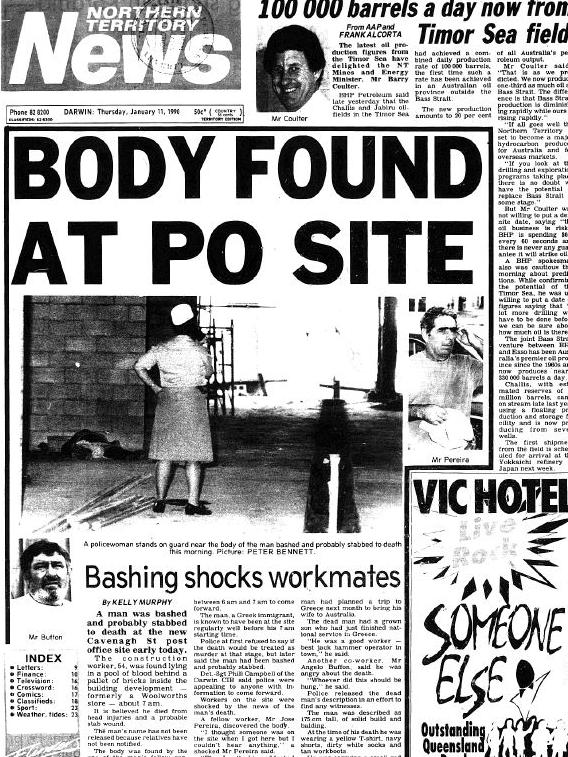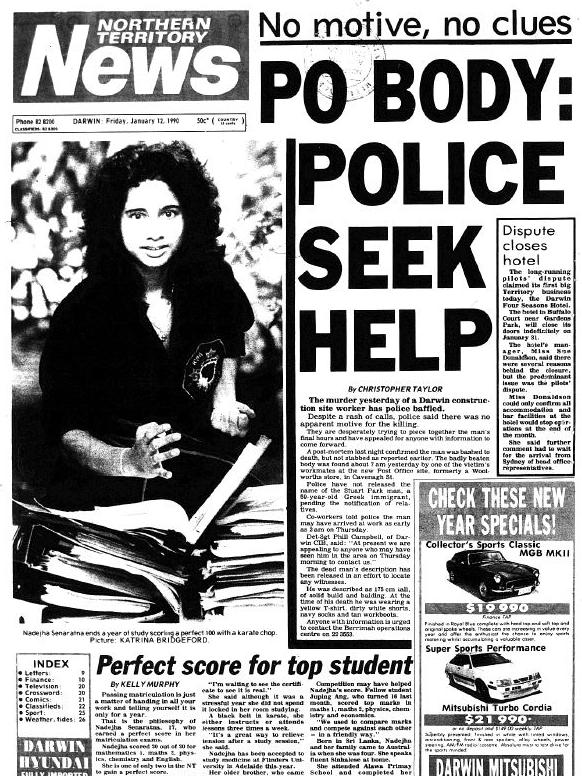IN the dead of night in the middle of Darwin, a loud clang rang out from inside the post office construction site.
So began one of the city’s most enduring murder mysteries, which baffled police from the beginning and which, nearly 30 years on, is unlikely to ever be solved.
Ioannis ‘John’ Fratzeskos was living the great migrant dream until that moment, just after 4am on January 11, 1990.
The clang was, according to police, “a person or persons unknown” clobbering builders labourer Fratzeskos in the head with a besser block, likely killing him instantly.
Police and Fratzeskos’s family and friends were stumped over why anyone would kill the quiet, hard working migrant.
“Agatha Christie could not have done it better,” the NT News reported within a week.
The rumour mill ran hot and an old-school, shoe-leather police investigation pieced together virtually everything that happened in hours before dawn near where Fratzeskos died, except for who was responsible for Fratzeskos’s seemingly unprovoked murder.

■ ■ ■
FRATZESKOS was a gentle chap with odd habits.
Unable to read or tell the time, he would often wake in the middle of the night and fear he would be late for work if he went back to sleep, so would walk from his granny flat at Miegs Cres, Stuart Park to whatever building site he was working at.
Once at work, sometimes as early as 2am, Fratzeskos would sit on his Esky, nap on a piece of cardboard, watch people stream out of Fannies Nightclub and eat his breakfast until his workmates arrived just before 7am.
But when Fratzeskos’s workmate Jose Pereira showed up to work on January 11, Fratzeskos wasn’t sitting on his Esky eating breakfast as usual.
He was dead.
A trail of blood led to Fratzeskos’s body, which crime scene examiners concluded had been dragged behind a pallet of bricks, out of sight from early morning passers-by.
“I called his name and got no answer,” Mr Pereira told police later that day in his broken English.
“I saw John laying on the ground. He had blood on his face and I though he might be sleeping. I did not touch him, I just called his name two or three times. I got no answer and I thought there must be something wrong.”
Mr Pereira ran to fetch the site foreman, Alex Gaal, who unlocked the site office and rang his boss Guiseppe Randazzo.
Within minutes, two police officers pulled up, just after the start of their shifts, and found Fratzeskos’s body beside a bloody Besser block, his shorts and underwear pulled down around his ankles and his wallet — still stuffed with cash — by his side.
Underneath Fratzeskos’s body were four unopened packets of condoms.
An autopsy later that day confirmed the obvious, that Fratzeskos died from a single, blunt blow to the head.

■ ■ ■
THE Darwin rumour mill immediately went into overdrive and police were inundated with tip-offs.
But a painstaking police investigation in the first month after Fratzeskos’s death kept running into dead ends. Shoe prints left in Fratzeskos’s blood at the crime scene most likely came from a Parnell Matterhorn boot, of which less than 100 pairs were sold in Australia and only at a few shoe shops in Victoria.
Dozens of people rang in to report “suspicious” itinerants hanging around the post office site.
No fingerprints were found on Fratzeskos’s wallet, or on the soft drink cans, iced coffee cartons and rubbish scattered nearby the body.
A man living nearby who had trouble sleeping that night, Ron Dixon reported “what sounded like sheet iron or blocks or a solid object falling” about 4am before a white ute drove away from the construction site, through otherwise deserted streets.
When police tracked down a man living in Darwin’s northern suburbs who drove white Victorian registered ute, they seized every pair of shoes he owned, none of which matched any of the shoe prints left in dust and blood at the building site.
A similar ute, found abandoned in Palmerston, had been stolen the night before Fratzeskos died but the insomniac was adamant it was not a match for the one he saw.
Another report from a cabbie who saw a white Falcon ute with a roof rack fitted parked near the building site within minutes of when Fratzeskos is believed to have been killed similarly came to nothing.
A second man who lived nearby and who was struggling to sleep that night, David O’Dea, was out walking his dog and told police he heard a noise “like a scream, it sounded like it was aggravated and then it got to a certain point and then it suddenly stopped”.
Two men ran past him, and grainy video camera footage from the 1990s nightclub showed men running down Cavenagh St who looked similar to the men who had run past Mr O’Dea and his dog.
But everyone police could find who looked like the men seen running in the security camera footage gave stories which checked out explaining their whereabouts that morning.
Years before DNA become commonplace in police investigations, the bloodstained besser block used to kill Fratzeskos was carted off to storage, while Fratzesko’s son, Skevos, flew to Darwin to take his father’s body back to Kalymnos.

■ ■ ■
MORE than a year after Fratzeskos was murdered, Detective Constable Anne Mosely sat in the Darwin Coroner’s Court and told of the sheer frustration of every promising lead running into a dead end.
Police, Constable Moseley told the 1991 inquest, had been given a lot of “bum steers”, and while of the people who phoned in were genuinely trying to help, others were “in bad faith”. “There have been no person or persons identified as bearing any grudges or disliking the deceased, nor has any motive arisen for anyone knowing the deceased to commit this crime,” Constable Moseley’s memo to the coroner said.
Fratzeskos, Constable Moseley said, “appeared to be a hard working man of sober habits”.
“Unless further information is received this matter will remain outstanding as a murder committed by a person or persons unknown,” the memo concludes.
By the time Dr Lowndes delivered an open finding into the circumstances surrounding his Fratzeskos’s murder, the investigation had been sitting untouched for months, with every promising lead having turned out to be a red herring.
A hand-written note on last page of the brief to then Coroner, Dr John Lowndes from Detective Superintendent Trevor Green said: “This is a suspicious death which has been thoroughly investigated — however the offender/s have not been identified.
“Police inquiries are continuing but there are no current avenues of inquiry which are likely to produce results.”
Steve Poullas, one of Fratzeskos’s cousins in Darwin said at the time, “my telephone has not stopped — all the family in Greece want to know why, why, why”.
“There is no reason for this, that’s what we are trying to find difficult to understand.
“He did not have any enemies. All he did was work, work, work.”

■ ■ ■
FRATZESKOS’S murder was as puzzling as it was captivating, so much so that a public appeal for new leads into the case was used to launch Crime Stoppers in the Northern Territory in 1996.
Four years after that, when DNA evidence was becoming a routine part of the police toolkit, Detective Sergeant Les “Chappy” Chapman asked for the besser brick to be pulled out of storage.
“The chap in charge had thrown the brick out,” Sgt Chapman said after he retired.
The best chance police would have at solving the murder — by lifting skin fragments off the brick which the killer had almost certainly left behind — is in all likelihood buried in landfill at the Shoal Bay tip.
And nearly three decades after Jose Pereira arrived for a day at work only to find his friend murdered, the question which appeared in bold font in the NT News the week after Fratzeskos died remains unanswered: “who killed Ioannis Fratzeskos?”


Fight of his life: How a 24-year-old rugby player beat bowel cancer
A young and fit aspiring professional rugby player endured 510 days of hell as he fought the toughest battle of his life: bowel cancer. Watch the sit-down interview here.
From the Top End to SA: Untold stories shared in new book on railway history
Russians, railways, bridge thefts, and more – one author’s 20-year project on the untold history of the railways between Darwin and Adelaide has hit the shelves of Territory book stores.